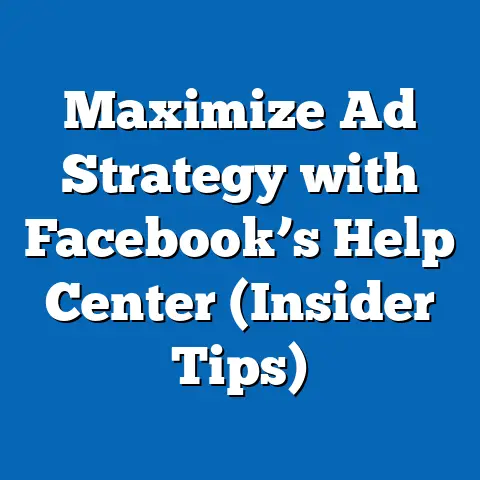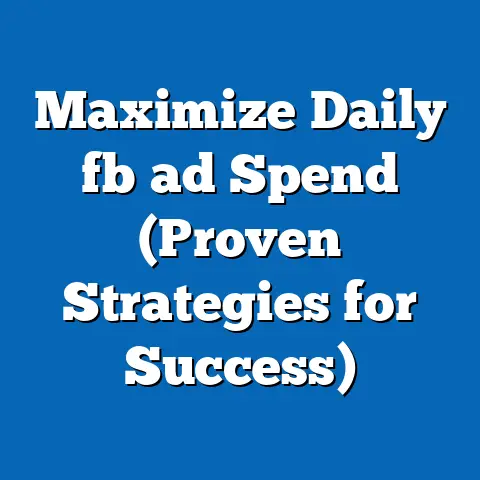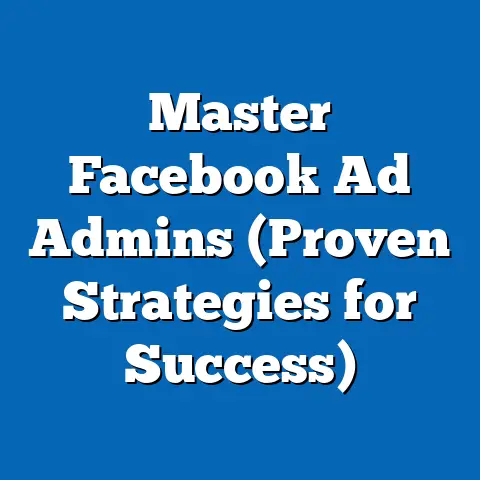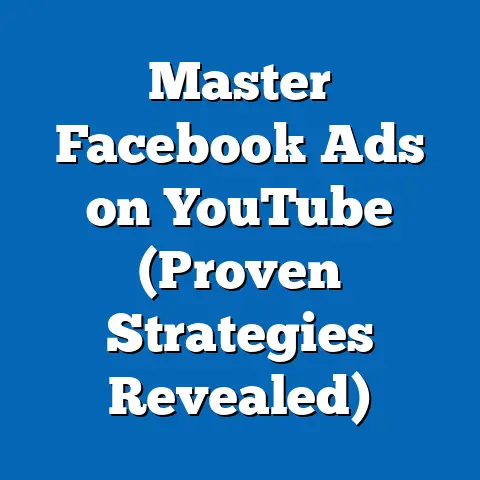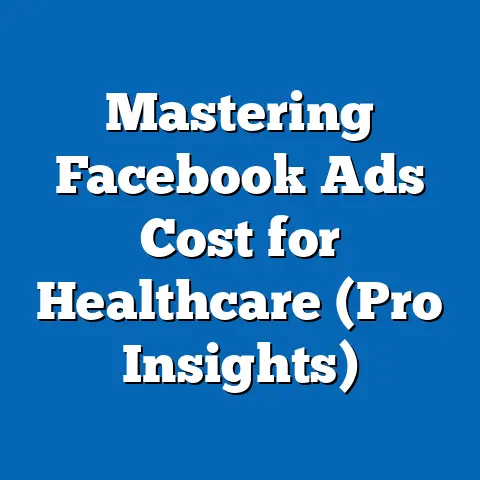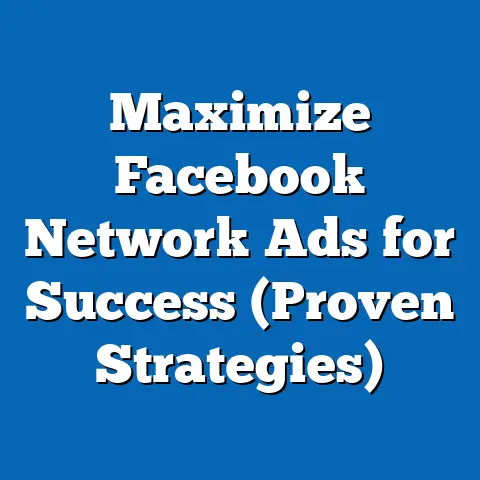Boost Facebook Ads: Check Performance Like a Pro (Expert Strategies)
Have you ever felt like you’re throwing money into a black hole with your Facebook Ads? I know I have. I remember working with a local bakery a few years back. They were running ads, but the results were… lackluster. Crickets. They were getting some website traffic, but no one was ordering custom cakes, which was their primary goal. They were frustrated, almost ready to give up on Facebook Ads altogether.
Then, we dove deep into the Ads Manager, really dissecting the data. We discovered that their ads targeting “cake lovers” were performing horribly, but ads targeting people interested in “wedding planning” were showing promise. A simple tweak – shifting the budget to the wedding crowd and tailoring the ad copy to mention wedding cakes – resulted in a 300% increase in inquiries within two weeks! That was my “aha” moment, solidifying the power of diligent performance monitoring and strategic adjustments.
If you’re struggling to see the ROI you expect from your Facebook Ads, you’re not alone. But the good news is, you can turn things around. In this guide, I’ll walk you through the essential strategies I use to check Facebook Ad performance like a pro. We’ll cover everything from understanding the Facebook Ads ecosystem to leveraging advanced analytics techniques, so you can transform your ads from cost centers into powerful growth engines.
Understanding the Facebook Ads Ecosystem
Facebook is a giant, no doubt about it. With billions of active users, it’s a dominant advertising platform, offering unparalleled reach and targeting capabilities. This vast user base presents an incredible opportunity to connect with potential customers, whether your goal is to build brand awareness, generate leads, or drive sales.
However, simply throwing ads onto Facebook and hoping for the best isn’t going to cut it. Success starts with setting clear, measurable objectives. Are you trying to increase brand visibility? Drive traffic to your website? Generate leads for your sales team? Your objectives will dictate the types of ads you run and the metrics you need to track.
That’s where performance metrics come in. Think of them as your compass, guiding you toward ad success. Without them, you’re sailing blind. They provide insights into how your ads are performing, what’s working, and what’s not. By carefully monitoring and analyzing these metrics, you can make data-driven decisions to optimize your campaigns and maximize your ROI.
Key Takeaway: Before you even think about running a Facebook Ad, define your objectives. Then, understand that performance metrics are your roadmap to achieving those objectives.
Key Performance Indicators (KPIs) to Monitor
Now, let’s get down to the nitty-gritty: the essential KPIs you need to be tracking. These metrics provide a comprehensive overview of your ad performance and help you identify areas for improvement.
Here are the KPIs I consider crucial for every Facebook advertiser:
-
Click-Through Rate (CTR): This is the percentage of people who saw your ad and clicked on it. It’s calculated as (Total Clicks / Total Impressions) * 100.
- Why it’s important: CTR is a direct indicator of how engaging your ad creative and copy are to your target audience. A high CTR means your message resonates, while a low CTR suggests your ad isn’t capturing attention.
- How to interpret it: A good CTR varies depending on your industry, target audience, and ad type. However, a CTR above 1% is generally considered good, while anything above 2% is excellent. If your CTR is below 1%, experiment with different ad copy, images, or targeting options.
- Relationship to other metrics: CTR directly impacts your CPC. A higher CTR can often lead to a lower CPC, as Facebook rewards ads that are engaging and relevant to users.
-
Cost Per Click (CPC): This is the amount you pay each time someone clicks on your ad. It’s calculated as (Total Ad Spend / Total Clicks).
- Why it’s important: CPC is a key indicator of the efficiency of your ad spend. Lowering your CPC allows you to drive more traffic to your website or landing page for the same budget.
- How to interpret it: Average CPCs vary significantly across industries and targeting options. Research industry benchmarks to get an idea of what’s considered a good CPC for your niche. Generally, the lower the CPC, the better.
- Relationship to other metrics: CPC is closely tied to CTR and Conversion Rate. A high CTR and a good Conversion Rate can justify a higher CPC, as you’re ultimately driving valuable actions.
-
Conversion Rate: This is the percentage of people who clicked on your ad and then completed a desired action, such as making a purchase, filling out a form, or downloading a resource. It’s calculated as (Total Conversions / Total Clicks) * 100.
- Why it’s important: Conversion Rate is the ultimate measure of your ad’s effectiveness in achieving your business goals. It tells you how well your ads are turning clicks into valuable actions.
- How to interpret it: A good Conversion Rate depends on your industry, the complexity of the desired action, and the quality of your landing page. Aim for a Conversion Rate above 2%, but strive to improve it continuously through optimization.
- Relationship to other metrics: Conversion Rate is closely linked to CPC and ROAS. A high Conversion Rate can justify a higher CPC, as you’re generating valuable conversions. It also directly impacts your ROAS.
-
Return on Ad Spend (ROAS): This is the amount of revenue you generate for every dollar you spend on advertising. It’s calculated as (Total Revenue Generated from Ads / Total Ad Spend).
- Why it’s important: ROAS is the ultimate measure of your ad’s profitability. It tells you whether your ads are generating a positive return on investment.
- How to interpret it: A ROAS of 1.0 means you’re breaking even. A ROAS above 1.0 means you’re generating a profit. Aim for a ROAS that’s significantly higher than 1.0 to ensure your ads are contributing to your bottom line.
- Relationship to other metrics: ROAS is directly influenced by Conversion Rate and Average Order Value. Increasing your Conversion Rate and Average Order Value will directly increase your ROAS.
-
Impressions and Reach:
- Impressions: The number of times your ad was displayed.
- Reach: The number of unique people who saw your ad.
- Why they’re important: These metrics give you a sense of your ad’s visibility. High impressions with low reach might indicate frequency issues (people seeing your ad too often), while low impressions could mean your audience is too narrow.
- How to interpret them: Track trends over time. If impressions are declining, it might be time to refresh your ad creative. If reach is limited, consider expanding your targeting.
- Relationship to other metrics: These metrics feed into your CTR. If people are seeing your ad but not clicking, you need to improve its relevance and appeal.
Click-Through Rate (CTR): This is the percentage of people who saw your ad and clicked on it. It’s calculated as (Total Clicks / Total Impressions) * 100.
- Why it’s important: CTR is a direct indicator of how engaging your ad creative and copy are to your target audience. A high CTR means your message resonates, while a low CTR suggests your ad isn’t capturing attention.
- How to interpret it: A good CTR varies depending on your industry, target audience, and ad type. However, a CTR above 1% is generally considered good, while anything above 2% is excellent. If your CTR is below 1%, experiment with different ad copy, images, or targeting options.
- Relationship to other metrics: CTR directly impacts your CPC. A higher CTR can often lead to a lower CPC, as Facebook rewards ads that are engaging and relevant to users.
Cost Per Click (CPC): This is the amount you pay each time someone clicks on your ad. It’s calculated as (Total Ad Spend / Total Clicks).
- Why it’s important: CPC is a key indicator of the efficiency of your ad spend. Lowering your CPC allows you to drive more traffic to your website or landing page for the same budget.
- How to interpret it: Average CPCs vary significantly across industries and targeting options. Research industry benchmarks to get an idea of what’s considered a good CPC for your niche. Generally, the lower the CPC, the better.
- Relationship to other metrics: CPC is closely tied to CTR and Conversion Rate. A high CTR and a good Conversion Rate can justify a higher CPC, as you’re ultimately driving valuable actions.
Conversion Rate: This is the percentage of people who clicked on your ad and then completed a desired action, such as making a purchase, filling out a form, or downloading a resource. It’s calculated as (Total Conversions / Total Clicks) * 100.
- Why it’s important: Conversion Rate is the ultimate measure of your ad’s effectiveness in achieving your business goals. It tells you how well your ads are turning clicks into valuable actions.
- How to interpret it: A good Conversion Rate depends on your industry, the complexity of the desired action, and the quality of your landing page. Aim for a Conversion Rate above 2%, but strive to improve it continuously through optimization.
- Relationship to other metrics: Conversion Rate is closely linked to CPC and ROAS. A high Conversion Rate can justify a higher CPC, as you’re generating valuable conversions. It also directly impacts your ROAS.
Return on Ad Spend (ROAS): This is the amount of revenue you generate for every dollar you spend on advertising. It’s calculated as (Total Revenue Generated from Ads / Total Ad Spend).
- Why it’s important: ROAS is the ultimate measure of your ad’s profitability. It tells you whether your ads are generating a positive return on investment.
- How to interpret it: A ROAS of 1.0 means you’re breaking even. A ROAS above 1.0 means you’re generating a profit. Aim for a ROAS that’s significantly higher than 1.0 to ensure your ads are contributing to your bottom line.
- Relationship to other metrics: ROAS is directly influenced by Conversion Rate and Average Order Value. Increasing your Conversion Rate and Average Order Value will directly increase your ROAS.
Impressions and Reach:
- Impressions: The number of times your ad was displayed.
- Reach: The number of unique people who saw your ad.
- Why they’re important: These metrics give you a sense of your ad’s visibility. High impressions with low reach might indicate frequency issues (people seeing your ad too often), while low impressions could mean your audience is too narrow.
- How to interpret them: Track trends over time. If impressions are declining, it might be time to refresh your ad creative. If reach is limited, consider expanding your targeting.
- Relationship to other metrics: These metrics feed into your CTR. If people are seeing your ad but not clicking, you need to improve its relevance and appeal.
Average Benchmarks: It’s crucial to understand that average benchmarks vary greatly depending on your industry, target audience, and ad objectives. However, here are some general guidelines:
- CTR: 1-2% (higher is better)
- CPC: $0.50 – $2.00 (lower is better)
- Conversion Rate: 2-5% (higher is better)
- ROAS: Above 1.0 (significantly higher is ideal)
Remember, these are just averages. Your goal should be to continuously improve your own performance relative to your own benchmarks.
Relating KPIs to Business Goals and Customer Journey Stages: It’s crucial to understand how these KPIs align with your overall business goals and the different stages of the customer journey. For example:
- Brand Awareness: Focus on Reach, Impressions, and Frequency.
- Lead Generation: Focus on CTR, CPC, and Conversion Rate (for lead form submissions).
- Sales Conversions: Focus on Conversion Rate (for purchases), ROAS, and Average Order Value.
By aligning your KPIs with your specific goals and the stage of the customer journey, you can gain a deeper understanding of your ad performance and make more informed optimization decisions.
Key Takeaway: These five KPIs are your core metrics for understanding Facebook Ad performance. Track them diligently, compare them to industry benchmarks, and use them to guide your optimization efforts.
Utilizing Facebook Ads Manager for Deep Insights
Facebook Ads Manager is your command center for all things advertising. It’s packed with features and functionalities that allow you to monitor your ad performance, analyze data, and make informed optimization decisions. But navigating this tool can be overwhelming, especially for beginners.
Here’s a guide to utilizing Facebook Ads Manager for deep insights:
-
Navigating the Interface: Start by familiarizing yourself with the Ads Manager interface. The main sections include:
- Campaigns: This is where you manage your overall advertising campaigns.
- Ad Sets: This is where you define your target audience, budget, and schedule.
- Ads: This is where you create your individual ads with images, copy, and call-to-action buttons.
-
Customizing Reports: The real power of Ads Manager lies in its ability to customize reports. You can choose which metrics to display, filter data by date range, and segment data by various dimensions (e.g., age, gender, placement).
-
Focus on Specific KPIs: Create custom reports that focus on the KPIs that matter most to your campaigns. For example, if you’re running a lead generation campaign, create a report that displays CTR, CPC, Conversion Rate (for lead form submissions), and Cost Per Lead.
- Segment Data: Segment your data to uncover insights about different demographics and interests. For example, you can segment your data by age to see which age groups are most responsive to your ads. You can also segment by placement to see which placements (e.g., Facebook News Feed, Instagram Feed, Audience Network) are performing best.
-
A/B Testing: A/B testing is a powerful technique for optimizing your ads. It involves creating two versions of an ad (A and B) with slight variations (e.g., different images, different headlines, different call-to-action buttons) and then running them simultaneously to see which version performs better.
-
Test Different Elements: Experiment with different ad elements to see what resonates best with your audience. Test different images, headlines, body copy, call-to-action buttons, and targeting options.
- Analyze the Results: Carefully analyze the results of your A/B tests to identify the winning variations. Use these insights to optimize your ads and improve your overall performance.
Navigating the Interface: Start by familiarizing yourself with the Ads Manager interface. The main sections include:
- Campaigns: This is where you manage your overall advertising campaigns.
- Ad Sets: This is where you define your target audience, budget, and schedule.
- Ads: This is where you create your individual ads with images, copy, and call-to-action buttons.
-
Customizing Reports: The real power of Ads Manager lies in its ability to customize reports. You can choose which metrics to display, filter data by date range, and segment data by various dimensions (e.g., age, gender, placement).
-
Focus on Specific KPIs: Create custom reports that focus on the KPIs that matter most to your campaigns. For example, if you’re running a lead generation campaign, create a report that displays CTR, CPC, Conversion Rate (for lead form submissions), and Cost Per Lead.
- Segment Data: Segment your data to uncover insights about different demographics and interests. For example, you can segment your data by age to see which age groups are most responsive to your ads. You can also segment by placement to see which placements (e.g., Facebook News Feed, Instagram Feed, Audience Network) are performing best.
-
A/B Testing: A/B testing is a powerful technique for optimizing your ads. It involves creating two versions of an ad (A and B) with slight variations (e.g., different images, different headlines, different call-to-action buttons) and then running them simultaneously to see which version performs better.
-
Test Different Elements: Experiment with different ad elements to see what resonates best with your audience. Test different images, headlines, body copy, call-to-action buttons, and targeting options.
- Analyze the Results: Carefully analyze the results of your A/B tests to identify the winning variations. Use these insights to optimize your ads and improve your overall performance.
Customizing Reports: The real power of Ads Manager lies in its ability to customize reports. You can choose which metrics to display, filter data by date range, and segment data by various dimensions (e.g., age, gender, placement).
Focus on Specific KPIs: Create custom reports that focus on the KPIs that matter most to your campaigns. For example, if you’re running a lead generation campaign, create a report that displays CTR, CPC, Conversion Rate (for lead form submissions), and Cost Per Lead.
A/B Testing: A/B testing is a powerful technique for optimizing your ads. It involves creating two versions of an ad (A and B) with slight variations (e.g., different images, different headlines, different call-to-action buttons) and then running them simultaneously to see which version performs better.
Test Different Elements: Experiment with different ad elements to see what resonates best with your audience. Test different images, headlines, body copy, call-to-action buttons, and targeting options.
My Experience with A/B Testing: I once worked with an e-commerce client selling handmade jewelry. We ran an A/B test with two different ad images: one featuring a close-up of the jewelry and the other featuring a model wearing the jewelry. The ad with the model wearing the jewelry performed significantly better, with a 50% higher CTR and a 30% higher Conversion Rate. This simple A/B test helped us understand that our target audience preferred to see the jewelry in context, which allowed us to optimize our ads and drive more sales.
Key Takeaway: Facebook Ads Manager is your treasure trove of data. Learn to navigate it effectively, customize your reports, and leverage A/B testing to unlock deep insights into your ad performance.
Advanced Analytics Techniques
While the basic KPIs provide a solid foundation, diving into advanced analytics techniques can uncover hidden insights that take your ad performance to the next level. Here are a couple of advanced strategies I use:
-
Cohort Analysis: This involves grouping users based on shared characteristics (e.g., the date they clicked on your ad) and then tracking their behavior over time. This can help you understand how different cohorts of users are engaging with your website or app and identify patterns that might be missed by traditional analysis.
- Example: You could group users based on the date they clicked on your ad and then track their purchase behavior over the next 30 days. This would allow you to see if users who clicked on your ad in a particular week are more likely to make a purchase than users who clicked on your ad in a different week.
-
Attribution Modeling: This involves assigning credit to different touchpoints in the customer journey for driving conversions. This can help you understand which ads and channels are most effective in driving sales and allocate your budget accordingly.
-
Example: A customer might see your Facebook ad, click on it, visit your website, and then make a purchase a few days later after seeing a retargeting ad on Instagram. Attribution modeling would help you determine how much credit to assign to each touchpoint (the initial Facebook ad and the retargeting ad on Instagram) for driving the final purchase.
- Leveraging the Facebook Pixel:
- What it is: A snippet of code you place on your website to track user behavior after they click on your Facebook ad.
- Why it’s powerful: The Pixel provides a wealth of data about what users are doing on your site, allowing you to track conversions, build retargeting audiences, and optimize your ads for specific actions.
- How to use it: Make sure your Pixel is properly installed and tracking the events that matter most to your business (e.g., purchases, lead form submissions, adding items to cart). Use this data to create custom audiences for retargeting and to optimize your ads for conversions.
Cohort Analysis: This involves grouping users based on shared characteristics (e.g., the date they clicked on your ad) and then tracking their behavior over time. This can help you understand how different cohorts of users are engaging with your website or app and identify patterns that might be missed by traditional analysis.
- Example: You could group users based on the date they clicked on your ad and then track their purchase behavior over the next 30 days. This would allow you to see if users who clicked on your ad in a particular week are more likely to make a purchase than users who clicked on your ad in a different week.
-
Attribution Modeling: This involves assigning credit to different touchpoints in the customer journey for driving conversions. This can help you understand which ads and channels are most effective in driving sales and allocate your budget accordingly.
-
Example: A customer might see your Facebook ad, click on it, visit your website, and then make a purchase a few days later after seeing a retargeting ad on Instagram. Attribution modeling would help you determine how much credit to assign to each touchpoint (the initial Facebook ad and the retargeting ad on Instagram) for driving the final purchase.
- Leveraging the Facebook Pixel:
- What it is: A snippet of code you place on your website to track user behavior after they click on your Facebook ad.
- Why it’s powerful: The Pixel provides a wealth of data about what users are doing on your site, allowing you to track conversions, build retargeting audiences, and optimize your ads for specific actions.
- How to use it: Make sure your Pixel is properly installed and tracking the events that matter most to your business (e.g., purchases, lead form submissions, adding items to cart). Use this data to create custom audiences for retargeting and to optimize your ads for conversions.
Attribution Modeling: This involves assigning credit to different touchpoints in the customer journey for driving conversions. This can help you understand which ads and channels are most effective in driving sales and allocate your budget accordingly.
Example: A customer might see your Facebook ad, click on it, visit your website, and then make a purchase a few days later after seeing a retargeting ad on Instagram. Attribution modeling would help you determine how much credit to assign to each touchpoint (the initial Facebook ad and the retargeting ad on Instagram) for driving the final purchase.
Key Takeaway: Advanced analytics techniques can uncover hidden insights that help you optimize your ads and drive better results. Don’t be afraid to dive deeper into your data and experiment with different analytical approaches.
Real-Time Monitoring and Optimization
The world of Facebook advertising moves fast. What worked yesterday might not work today. That’s why real-time monitoring and optimization are crucial for staying ahead of the curve.
Here are some strategies for making data-driven decisions in real-time:
- Set Up Performance Alerts: Facebook Ads Manager allows you to set up performance alerts that notify you when your ads are underperforming or overspending. This allows you to take immediate action to address any issues.
- Pause Underperforming Ads: If you identify ads that are consistently underperforming (e.g., low CTR, high CPC, low Conversion Rate), don’t hesitate to pause them. Reallocate your budget to ads that are performing better.
- Reallocate Budgets: If you identify ad sets or campaigns that are performing exceptionally well, consider reallocating your budget to those areas. This can help you maximize your ROI.
- Scale Successful Campaigns: Once you’ve optimized your ads and are seeing positive results, consider scaling your campaigns. This can involve increasing your budget, expanding your targeting, or launching new ad variations.
- Leveraging Machine Learning and AI:
- Facebook’s algorithms are your friend: Take advantage of Facebook’s machine learning capabilities to optimize your ads. Use campaign budget optimization (CBO) to let Facebook automatically allocate your budget across ad sets.
- Trust the process: Give Facebook’s algorithms time to learn and optimize your ads. Don’t make drastic changes too quickly, as this can disrupt the learning process.
- But don’t be completely hands-off: While Facebook’s AI is powerful, it’s not a substitute for human oversight. Continue to monitor your ads and make strategic adjustments as needed.
- Facebook’s algorithms are your friend: Take advantage of Facebook’s machine learning capabilities to optimize your ads. Use campaign budget optimization (CBO) to let Facebook automatically allocate your budget across ad sets.
- Trust the process: Give Facebook’s algorithms time to learn and optimize your ads. Don’t make drastic changes too quickly, as this can disrupt the learning process.
- But don’t be completely hands-off: While Facebook’s AI is powerful, it’s not a substitute for human oversight. Continue to monitor your ads and make strategic adjustments as needed.
My biggest mistake? I’ve learned (the hard way) to trust the data. Early in my career, I had a gut feeling about an ad campaign. The numbers said it was failing, but I believed in it. I kept it running, hoping for a turnaround. It never came. I wasted valuable budget and time. Now, I follow the data, even when it goes against my initial instincts.
Key Takeaway: Real-time monitoring and optimization are essential for maximizing your Facebook Ad ROI. Set up performance alerts, pause underperforming ads, reallocate budgets, and scale successful campaigns.
Case Studies and Success Stories
Let’s bring these strategies to life with some real-world examples.
- Local Restaurant: A local restaurant was struggling to attract new customers. They ran Facebook Ads targeting people interested in “food” and “restaurants,” but the results were mediocre. After analyzing their data, they discovered that their ads targeting people interested in “local events” and “live music” were performing much better. They shifted their targeting to focus on these interests and created ads showcasing their live music events. This resulted in a 50% increase in foot traffic and a 30% increase in sales.
- Online Clothing Store: An online clothing store was struggling to convert website visitors into customers. They ran Facebook Ads driving traffic to their website, but the Conversion Rate was low. After implementing Facebook Pixel and tracking user behavior on their website, they discovered that many users were abandoning their shopping carts before completing their purchases. They created retargeting ads targeting these abandoned cart users with personalized offers (e.g., free shipping, discounts). This resulted in a 20% increase in Conversion Rate and a 15% increase in revenue.
- Software Company: A software company wanted to generate more leads for their sales team. They ran Facebook Ads promoting a free trial of their software. After analyzing their data, they discovered that their ads targeting specific job titles (e.g., “marketing manager,” “sales director”) were performing much better than their ads targeting broader interests. They refined their targeting to focus on these job titles and created ads that spoke directly to the needs of these professionals. This resulted in a 40% increase in lead generation and a 25% increase in sales qualified leads.
These are just a few examples of how effective monitoring and analysis can transform ad performance. By implementing the strategies I’ve outlined in this guide, you can achieve similar results for your own business.
Key Takeaway: Success stories abound! These case studies demonstrate the power of data-driven decision-making. Learn from these examples and apply the strategies to your own campaigns.
The Continuous Improvement Mindset
Mastering Facebook Ads is not a one-time task; it’s an ongoing journey. It requires diligence, a willingness to experiment, and a commitment to continuous improvement.
Regularly check your ad performance, analyze your data, and adapt your strategies based on the insights you gain. Don’t be afraid to try new things, test different approaches, and learn from your mistakes.
Remember, even small adjustments based on performance analysis can lead to substantial improvements in your advertising success. Embrace the process, stay curious, and continuously seek out new ways to enhance your ad campaigns for better results.
In Conclusion: Facebook advertising is a powerful tool, but it requires a strategic and data-driven approach. By understanding the Facebook Ads ecosystem, monitoring key performance indicators, utilizing Facebook Ads Manager for deep insights, employing advanced analytics techniques, and embracing real-time monitoring and optimization, you can transform your ads from cost centers into powerful growth engines. Remember, the key is to embrace the continuous improvement mindset and never stop learning and experimenting. Now, go forth and conquer the world of Facebook Ads!

